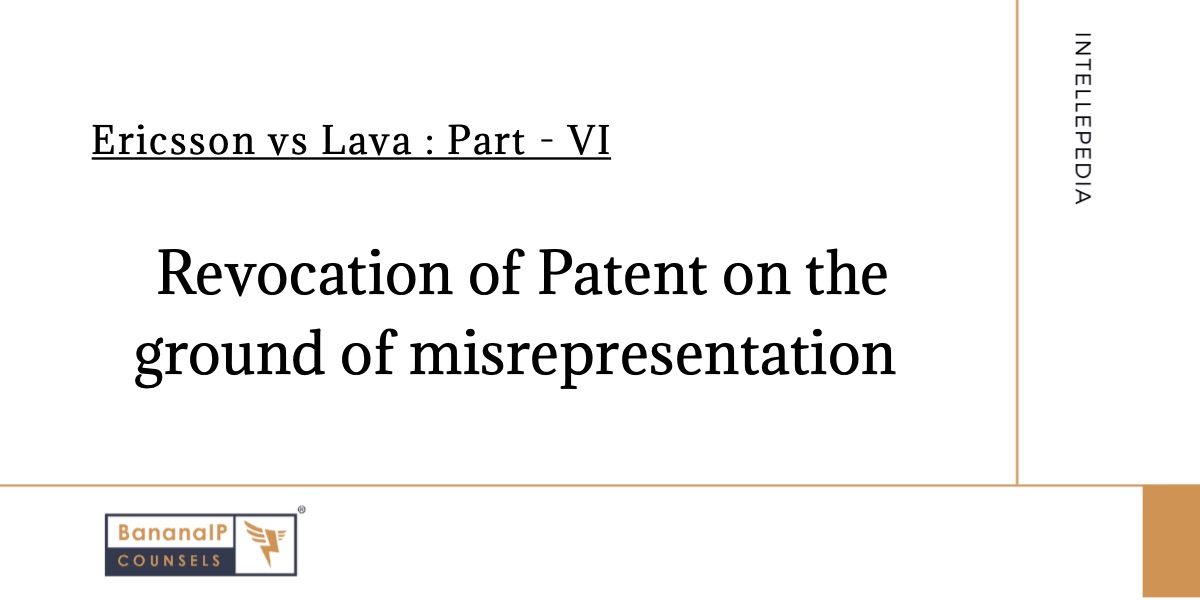Background
This post covers the aspects of revocation of a patent on the ground of misrepresentation as discussed by the Delhi High Court in the Lava & Ericsson case. The Court in this case noted that the threshold for proving such allegations is understandably high, requiring clear and convincing evidence of intentional wrongdoing. Mere allegations are not sufficient to revoke a patent; there must be a clear demonstration of intentional deceit. In line with this principle, the Court placed the onus of proof on Lava to prove that there was intentional misrepresentation by Ericsson.
Lava’s Submissions
Lava invoked the ground of revocation under Section 64(1)(j) read with Section 8(1) of the Patents Act, 1970. In support of its claims of misrepresentation by Ericsson, Lava stated as follows:
- Ericsson misled the Indian Patent Office by claiming that the suit patents are related to ‘devices’ or ‘apparatus’;
- Ericsson’s patent IN 241747 does not involve any hardware component and is only a basic technique used in internet protocols since the 1970s;
- Initially, Ericsson claimed that the suit patents were product patents and thereafter during oral submissions, Ericsson argued that the suit patents were algorithms with a technical effect; and
- Ericsson engaged in deliberate misrepresentation to secure the suit patents from the Indian Patent Office by shifting their characterization from product-based to algorithmic with technical effects.
Ericsson’s Submissions
Ericsson defended Lava’s allegations and substantiated as follows:
- It provided the Indian Patent Office with all details and required information including documents for the suit patents;
- All its suit patents are algorithms and relate to devices, apparatus, components and mobile stations, consequently, product patents;
- The suit patents cannot be labelled as algorithms;
- The algorithms are only a set of instructions and are thus, theoretical in nature; and
- Lava failed to provide any evidence to substantiate its claims regarding misrepresentation.
Applicable Precedents
The Court relied on the following cases:
- In the case of Sukesh Behl v. Koninklijke Phillips Electronics, 2014 SCC OnLine Del 2313, the Division Bench of the Delhi High Court stated,
“49. Under the circumstances, as rightly held by the learned Single Judge
revocation is not automatic under Section 64(1)(m), but it is always open to the Court to examine the question whether the omission to furnish the information was deliberate or intentional. The revocation would follow only if the Court is of the view that the omission to furnish the information was deliberate. …”
- In the case of Intex Technologies (India) Ltd. v. Telefonaktiebolaget L.M. Ericsson, 2023 SCC OnLine Del 1845, the Division Bench of the Delhi High Court stated,
“CHALLENGE UNDER SECTIONS 3 AND 8 OF THE ACT ARE NOT MADE OUT
-
-
- … This Court is in agreement with the aforesaid prima facie findings and is of the view that Intex has failed to show how Ericsson has deliberately suppressed any information relevant under Section 8 of the Act from the Patent Controller …
- …Defendant is obligated to demonstrate how the breach of Section 8 provision is “patent and manifest”. Without such evidence, the breach of Section 8 of the Act cannot be made the sole ground for non-grant of interim injunction …
- Consequently, the argument by Intex of a ‘Strict liability’ test for noncompliance of Section 8 is contrary to law and it was in this context that the learned Single Judge has rendered the following
-
findings:—
“105. The obligation of Section 8 cannot be so stressed in an action for infringement of patent is concerned, otherwise the injunction despite infringement cannot be granted in any matter for such a plea which appears to be false and frivolous. The same is not the scheme of the law.”
-
-
- … In any event, Intex has failed to show how non-production of any document by Ericsson was material to grant/non-grant of the patents.”
-
Analysis
Based on the aforementioned the Court stated as follows:
- Lava failed to present any substantial evidence to support the accusation of fraud or misrepresentation to the patent office.
- To successfully pursue the revocation of a patent on account of fraud or misrepresentation, it is essential to conclusively prove with cogent evidence that there has been deliberate or intentional misrepresentation(s) made by the patentee to the Indian Patent Office.
- The applicable provisions of the Patents Act [Sections 8 and 64(1)(m)] are designed to ensure that patents are granted based on accurate and truthful disclosures.
- The threshold for proving such allegations is quite high and requires clear and convincing evidence of intentional wrongdoing.
- Mere allegations are not sufficient to revoke a patent; there must be a clear demonstration of intentional deceit.
Finding
The Court held, therefore, given the lack of concrete evidence from Lava to support its contentions for revocation of the patents under Sections 64(1)(j) and 64(1)(m) of the Patents Act, the said claim is found to be unsubstantiated and is therefore, rejected.
Citation: Lava International Limited v. Telefonaktiebolaget LM Ericsson, High Court of Delhi, 28th March, 2024, CS(COMM) 65/2016, CS(COMM) 1148/2016 and CC(COMM) 14/2017.
Authored by Ms. Kavya Sadashivan, Consulting & Strategy Team, BananaIP Counsels.
Also read
Disclaimer
The case note/s in this blog post have been written by IP Attorneys at BananaIP Counsels based on their review and understanding of the Judgments. It may be noted that other IP attorneys and experts in the field may have different opinions about the cases or arrive at different conclusions therefrom. It is advisable to read the Judgments before making any decisions based on the case notes.
If you have any questions, or if you wish to speak with an IP expert/attorney, please reach us at: [email protected] or 91-80-26860414/24/34.



